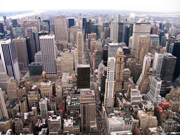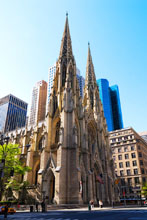To talk about New York’s culture is to talk about everything and nothing at the same time. It was a complex trapestry of cultures when it was founded, and so it has remained until halfway through the 20th century.
Since each culture didn’t know each other very well, they decided to stick to what they knew and a multitude of cultures, preoccupations and interests started to develop at the same time. Then every culture got mixed with the other and everything got a lot more complicated.

However, New York is perhaps the most culturally powerful city in America. Maybe it helps that it barely has any industry in it – the movie industry is in Los Angeles, the book industry is scattered all over America, the music industry is in different states depending on what genre you are thinking, and architecture has more or less been a Chicago specialty.
So what we are left with in New York is the barebones of any cultural development – an artist and its audience.
Does this make art in New York any truer, any better? Not necessarily. But it makes it different. What art comes from the Big Apple is undeniably Big Apple. A product that you can feel started with an artist wanting to say something, to be heard over the noise and the chaos, to change an established form (for instance, a genre, which is how we get so much indie music from New York; or even a product, which is how its food can be traced back to all over the world and still is done in a different manner in New York).

Take the city’s buildings, for instance.
New York has fantastic architecture. It was born out of necessity, because the city was expanding so rapidly, the authorities had to answer to its needs of else the world’s trade capital would collapse. But this doesn’t mean it is filled with dull, industrial-looking buildings (well, perhaps in Brooklyn).
The idea was reconverted and turned into the modern-day cathedrals that honor the modern-day god of the might dollar and which we call skyscrapers. This is more or less what happened, albeit with different ideals, with its religious architecture (it has many temples honoring very different gods, which mirrors New York’s religious laxitude, perhaps indifference) and its modernist architecture, of which the city has a more impressive array than a lot of travel guides would admit.
Then there’s cases like New York’s food, where the result is much more than the sum of its components. The city has next to no cuisine of its own – most of it is either Chinese or Italian or Creole or African American. Its immigrants brought their habits with it. And yet, you cannot compare a pizza cooked in New York with a pizza cooked in Italy. Deli was supposed to be an import as well and there it is, being the Big Apple’s most distinct meal. It has been transformed, perfected, refined – perhaps not improved, perhaps yes. That’s something for the audience to decide. But it is certainly different.
Music follows a similar example. It is rooted in very different places (in fact, even the songs played by New York’s ancient anti-immigrant population were new arrangement of old folk songs), and yet it has its own sound. It is too urban and sophisticated for American exhuberant standards, it is too boisterous for Classical standards, and too modern for traditional standards. Music created in this city has a sound of its own and record labels have been quick to cash in on that.
Then there’s cinema and theater. Activist Jerry Rubin once said that “Every person on the streets of New York is a type. The city is one big theater where everyone is on display.” Now let’s assume, for argument’s sake, that one is the evolution of the other – which is an overly simplistic approach but we’re not making an art treaty here. That statement perfectly encapsulates New York’s approach to the performing arts – its dichotomy both so perfectly theatrical in its character, so visually cinematographical and at the same time, perhaps narcissistically, hopelessly enamored with both theater and cinema.
That’s why Broadway theater became such an important industry in New York. And it’s also why New York not only has been the location for basically any American film that doesn’t specifically need to be set anywhere else. This also explains why there are so many high-quality movie theaters in New York.
New York doesn’t really have a culture. New York is culture.